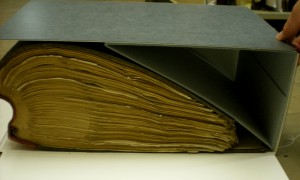Written By Erin Hammeke, Special Collections Conservator
This will be one of a series of blog posts on some of the neat bindings we’ve discovered in the bound manuscripts. Our Conservation team has been going through the collection of over 6,000 ledgers, item by item, in an effort to prepare them for move to the Library Service Center as a part of the Enabling Project. As we wrap them up, we felt it would be nice to share some of the gems that we come across along the way.
The bound manuscripts derive from a number of different collections. Many of them have personal content, such as scrapbooks, daybooks and diaries. Most of them appear to be business records, account books, and ledgers. Even though this collection as a whole is in poor condition, it has been interesting to see how many bindings have been carefully preserved and repaired by their previous owners during their working life. A number of bindings with deteriorated leather covers have been covered in canvas wrappers, oftentimes with hand-stitching at the turn-ins.
 Shown here are two bindings from a batch of about 30 items from the William Clark Grasty Papers(1788-1906). This collection of records documents “three generations of general merchants of Pittsylvania Co., Va. Business interests included a general store, a tavern, a blacksmith shop, a simplified type of banking, and the keeping of a post office.”
Shown here are two bindings from a batch of about 30 items from the William Clark Grasty Papers(1788-1906). This collection of records documents “three generations of general merchants of Pittsylvania Co., Va. Business interests included a general store, a tavern, a blacksmith shop, a simplified type of banking, and the keeping of a post office.”
These early 19th century bindings are notable because of their simple and beautiful handmade canvas covers. The text pages were sewn in by hand through the covers with a long-stitch sewing style. These items were likely considered essential to this business’s daily workings 200 years ago. Sadly, it is difficult to imagine a business keeping their records in a binding such as this today.





